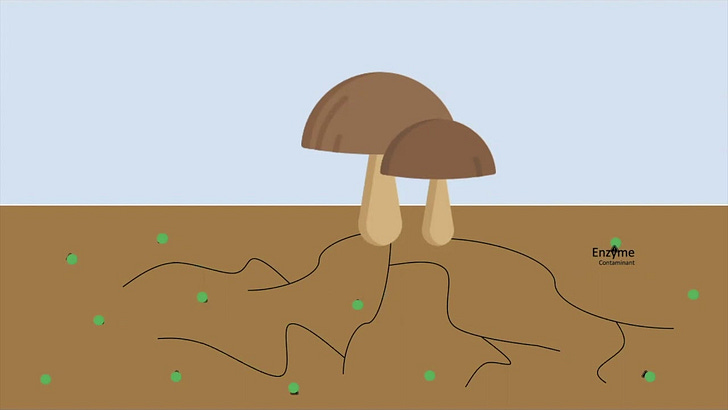With their special metal alteration and removal skills, fungi play a vital role in the bioremediation of metals. The Fungi Kingdom comprises eukaryotic (any cell or organism with a clearly defined nucleus)(Britannica, 2023) microorganisms called fungi. These organisms have a variety of metabolic properties that can be used in metal bioremediation applications. Various processes are used by fungi in metal bioremediation.
Biosorption: Chitin, glucans, and other polysaccharides found in fungus cell walls have the ability to bind and sequester metal ions. With their wide branching patterns, fungus mycelia offer a sizable surface area for metal adsorption. Fungi can remove metals from polluted fluids or surroundings thanks to their capacity for biosorption.
Extracellular enzyme production: A large range of extracellular enzymes that support metal biotransformation and mobilization are produced by fungi. For instance, certain fungi secrete enzymes that reduce metal ions to less harmful or mobile forms, such as reductases and nitrate reductases. These enzymes help metals change, which increases their susceptibility to future remediation procedures. “The metals necessary for fungal growth include copper, iron, manganese, molybdenum, zinc, and nickel. Nonessential metals commonly encountered include chromium, cadmium, lead, mercury, and silver [2]. The involvement of metal ions in the physiology of another group of wood-rotting fungi, the brown-rot fungi, has been reviewed [3]. Metal ions are involved in the decomposition of cellulose and hemicelluloses by brown-rot fungi. In white-rot fungi, copper and manganese directly participate in lignin degradation. Manganese participates in the reaction cycle of Mn-dependent peroxidase, and copper serves as a cofactor in the catalytic center of laccase.” (Baldwin, 2003)
Some fungi have the ability to sequester and collect metals within their cells. They have proteins like metallothioneins (MT) that trap and store metals inside fungal cells. “Metallothioneins are low molecular weight (6–7 kDa) proteins with 61–62 amino acid residues. The high content of cysteinyl residues (30%) confers them the ability to bind a variety of transition and heavy metals. Although not fully understood, The biological role of MT has been related to the homeostasis of essential elements, such as Zn (zinc) and Cu (copper), and the detoxification of heavy metals, such as Hg (mercury) and Cd (cadmium).” (Pedrero et al., 2012) Certain metals, including cadmium, copper, and uranium, can be hyperaccumulated by fungi and removed from the environment through their biomass.
Mycoremediation: Fungi are skilled at dissolving intricate organic molecules, such as those connected to metal pollutants. Fungi break down organic contaminants by mycoremediation, assisting indirectly with metal detoxification. This process incorporates the metabolic functions of fungi, which can promote the release of metals from organic complexes and assist their eventual cleanup. These functions include creating extracellular enzymes and breaking up organic materials.
Numerous studies have been done on specific fungi to determine how well they can bioremediate metals. In “Recent Advances in Biosorption of Copper and Cobalt by Filamentous Fungi,” Dusengemungu et al. discuss an extensive summary of several types of fungi that remediate metals, including the following:
Aspergillus spp.: The Aspergillus species are filamentous fungi ubiquitous in the environment. They possess many industrial applications, including practical applications in biosorption of heavy metals from contaminated sites. These species have enormous ability to create a metal sink coupled with their capacity to produce organic acids that can bioleach metals. There are four popular species of Aspergillus: A. niger, A. flavus, A. versicolor, and A. tamarii NRC 3 used for biosorption
Penicillium species: …the young Penicillium spp., mycelia, have a far greater capacity for heavy metal biosorption than the old mycelia. The potential of Penicillium biomass for removing metal ions from wastewaters… The data presented from their studies showed that Penicillium sp. had higher bioremediation potential for contaminated ecosystems compared to other filamentous fungi strains such as Aspergillus, Trichoderma, Fusarium, Alternaria, Geotrichum, Rhizopus, and Monilia.
Trichoderma species: Since the Trichoderma spp. are extremely interactive in soil and plant roots, they play a significant role in the environment by facilitating in the decomposition of plant residues, biodegradation of industrial chemicals as well as bioremoval/bioaccumulation of a wide range of heavy metals from wastewaters and soil, due to their unique cell-wall characteristics which are mainly composed of glucan polymers and chitin (Dusengemungu et al., 2020)
The choice of fungi, the surrounding environment, and the particular metal pollutants present all impact how efficient fungal bioremediation techniques are. For effective metal remediation, fungus-based bioremediation methods can be utilized alone or with other strategies like bacterial consortia or physical-chemical procedures.
Fungi present enormous potential for the bioremediation of metals because of their wide range of metabolic capacities, tolerance of severe settings, and capacity to interact with metals. Fungal-based bioremediation techniques are still under investigation, but they promise to reduce metal contamination and enhance environmental health.
Resources
Baldrian, Petr. Interactions of heavy metals with white-rot fungi. Enzyme and Microbial Technology. Volume 32, Issue 1. 2003. Pp 78-91. ISSN 0141-0229. https://doi.org/10.1016/S0141-0229(02)00245-4. https://www.sciencedirect.com/science/article/pii/S0141022902002454
Britannica, T. Editors of Encyclopaedia (2023, April 25). eukaryote. Encyclopedia Britannica. https://www.britannica.com/science/eukaryote
Dusengemungu, L., Kasali, G., Gwanama, C., & Ouma, K. O. (2020). Recent Advances in Biosorption of Copper and Cobalt by Filamentous Fungi. Frontiers in Microbiology, 11, 582016. https://doi.org/10.3389/fmicb.2020.582016
Pedrero, Z. , L Ouerdane, S., Mounicou, R., Lobinski, M., Monperrus, D. Amouroux. Identification of mercury and other metals complexes with metallothioneins in dolphin liver by hydrophilic interaction liquid chromatography with the parallel detection by ICP MS and electrospray hybrid linear/orbital trap MS/MS. Metallomics, Volume 4, Issue 5, May 2012, Pages 473–479, https://doi.org/10.1039/c2mt00006g



